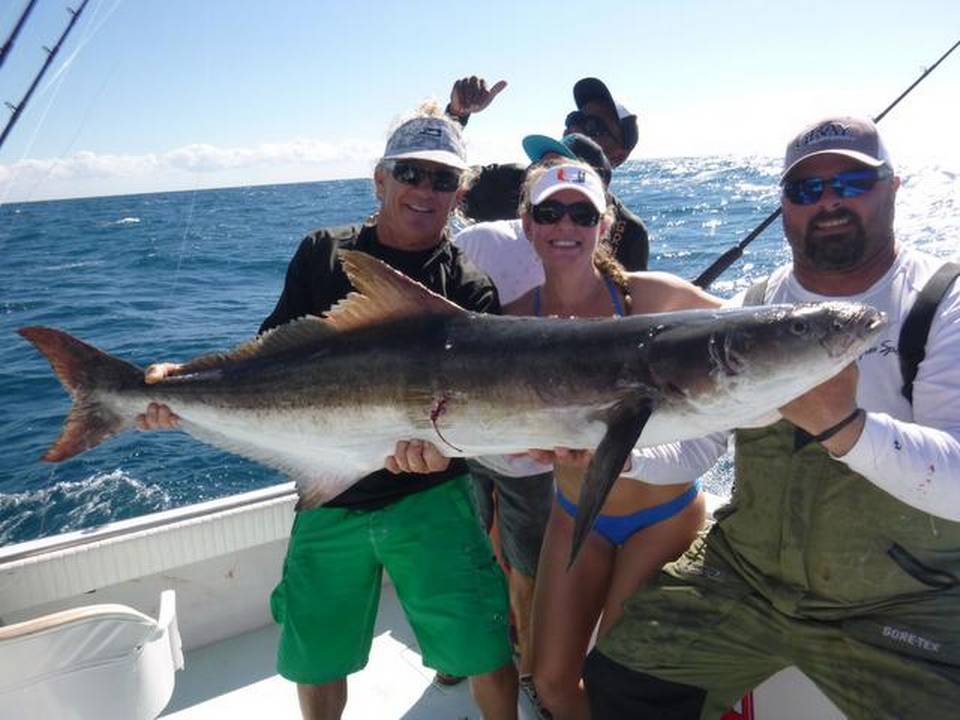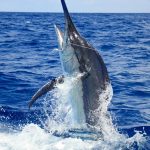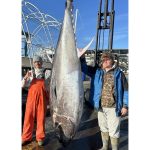Above: Winning crew – The crew of “Free Spool” celebrates Mindy Marks’ 54-pound cobia, caught on the way to winning the Dust ‘Em Off Sailfish Warm-Up. Photo Credit: Sue Cocking. Miami Herald Staff.
South Florida’s 2014-15 sailfish tournament season got off to a promising early start with last month’s inaugural “Dust ‘Em Off Sailfish Warm-Up” where a fleet of 18 boats released 40 sails in a single day. Captain Dennis Forgione’s charterboat Free Spool took top honors with angler Mindy Marks scoring five releases — all in about 109 feet of water off Haulover Inlet.
But the outlook for the rest of the season, which wraps up in mid to late April, isn’t as bright.
Oceanographer Mitch Roffer, who operates Roffer’s Ocean Fishing Forecasting Service for offshore anglers throughout the Atlantic, Caribbean and Gulf of Mexico, predicts a so-so season.
Roffer, who uses satellites to track ocean currents, temperatures and other data to help anglers target their favorite pelagic species, says most weather forecasts point to a mild winter.
“That suggests an average season — nothing great,” he said. “We’re in a cycle that the last couple years have been relatively warm.”
Roffer says he believes there’s a group of sailfish that lives in Miami’s coastal waters year round, but that the greatest numbers of fish are pushed down here from the north by cold weather. Ideal water temperatures for the spindle beaks, he said are 72 to 76 degrees.
“If the lens of water 72 to 76 degrees is tight between Jupiter and Miami, it’ll be a good sailfish season,” he said. “If the lens extends all the way to Key West and it’s spread out, it’s not going to be that good.”
Roffer said the position of the Gulf Stream — a strong ocean current that rushes north all the way up the eastern seaboard — also is an important factor in sailfish success.
“If the west wall of the Gulf Stream is pushing in along with a wind from the northwest, it tightens up that gradient and causes the fish to concentrate on those Gulf Stream filaments that really produces the best,” he said. The opposite is true if the west wall remains stable or pushes away from the coast.
Last weekend’s cold front, he said, was too short-lived to prod big numbers of fish to move south toward the bait spreads of recreational and tournament fishers in South Florida.
Forgione believes the key to his early-season tournament win was to position his bait spread around underwater structure, such as wrecks and rubble piles, that ring the waters outside Haulover Inlet. The captain’s reasoning was that, minus cold weather and a strong northerly current, the mostly resident sailfish would stick to upwellings created by the structures that tend to attract bait.
“It looked to me like they came from the south,” Forgione said of the sailfish. “They might have been circling that whole area.”
The strategy worked so well that Free Spool not only won the tournament, but captured a 54-pound cobia hanging around one of the wrecks.
Roffer says that shows a lackluster sailfish bite is no reason to remain at the dock.
“A day on the water is better than a day in the office,” the scientist said. “It’s not like you go out there and it’s sailfish or nothing.”
IF YOU GO
South Florida’s sailfish tournament season is just getting started. Here’s a partial list of tournaments being held over the next couple of months:
AT&T Jeb Bush Florida Classic, Wed.-Fri., Fort Lauderdale; Islamorada Sailfish Tournament, Dec. 4-7, Islamorada; Operation: Sailfish, Dec. 10-14, West Palm Beach; 78th Annual Silver Sailfish Derby, Jan. 8-10, Singer Island; Sailfish 400, Jan. 14-18, Miami; Cheeca Lodge Presidential Sailfish Tournament, Jan. 15-17, Islamorada; Islamorada Fishing Club tournament, Jan. 22.
To learn more about how ocean currents and temperature breaks affect offshore fishing, visit roffs.com.
This article is re-posted from miamiherald.com – please click here for original article.






